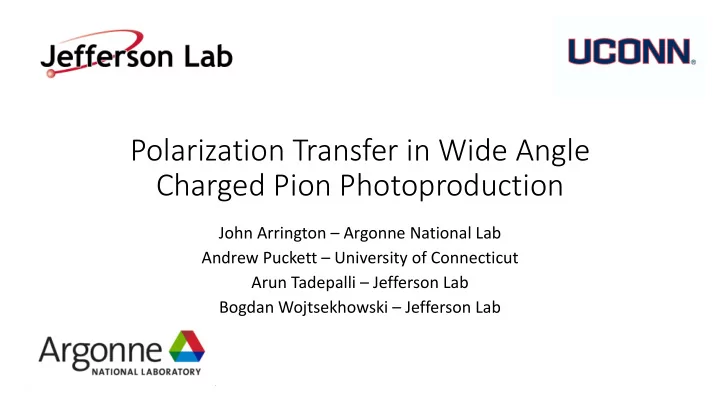

Polarization Transfer in Wide Angle Charged Pion Photoproduction John Arrington – Argonne National Lab Andrew Puckett – University of Connecticut Arun Tadepalli – Jefferson Lab Bogdan Wojtsekhowski – Jefferson Lab
The spokespersons John Arrington Andrew Puckett Arun Tadepalli Bogdan Wojtsekhowski 2
> 60 collaborators! 3
Contents • Field of Meson Photoproduction • Observed yet unexplained cross sections • Theoretical efforts • Possible solution: Polarization tests of handbag mechanism? • What are we proposing? • Summary 4
Meson Photo- and Electroproduction • Has been around for quite some time! • Early measurements at Stanford conducted to study the ratio of the pions produced due to electro and photo production 5
Measurements of exclusive photoproduction • Other measurements of exclusive photoproduction were conducted which revealed intriguing features 6
Measurements conducted for a variety of physics processes and particles 7
Mechanism of scaling • Continuing interest in the features but the cross sections are still unexplained • Models tried to explain the observed cross sections by considering the number of “active fields” involved in the photoproduction • CCR (Constituent Counting Rules) • HHC (Hadron Helicity Conservation) • pQCD (perturbative QCD) • Handbag approach in the GPD framework (Generalized Parton Distributions) 8
Photoproduction experiments in Hall A • Photoproduction experiments conducted in Hall A using LHRS and RHRS • π + and π - cross sections and their ratios studied for a range of s and t • Many intriguing features that still have continued interest at Jefferson Lab 9
Experiment in Hall A E94-104 10
But calculations fall short! 11
π 0 photoproduction experiments in Hall B • Calculations using the Handbag approach fall short by more than two orders of magnitude • Missing some crucial information in the amplitude used in calculations • Figuring that out will shed light on the interaction mechanism responsible for these cross sections 12
Calculations with higher twists • Calculations with twist 2 and twist 3 contributions performed for π 0 • They are in reasonable agreement (black curve) with CLAS data • Polarization test of the handbag mechanism is necessary and timely 13
Helicity correlation observables • Helicity correlations A LL and K LL provide tests of the handbag mechanism • Twist 3 contribution dominates twist 2 • Predictions made for π 0 and π - 14
Predictions for π - • Measurements have been conducted for WACS for π 0 which show good agreement with handbag mechanism • Calculations made by Kroll et al for WAPP π - case • Measurement will test the calculations as well as provide constraints for other models • This measurement is fundamental, important and the first of its kind in the wide angle regime! 15
Experimental setup: same as GEn-RP setup • 6.6 GeV electron beam (photons in the range 4.0 – 6.0 GeV) • LD2 target with 6% Cu radiator upstream • BigBite as the pion arm • SBS as the nucleon arm 16
Mandelstam variables >> λ QCD to test out handbag mechanism 17
18
Energy deposition in the preshower and shower • GEn-RP trigger designed to have increased e - efficiency • Threshold cuts have to be applied on at the trigger level to suppress e - and increase pion detection efficiency • Need to demonstrate the feasibility of such a configuration change 19
Projected results for K LL Just 48 hours with 16 hours beam energy change procedure (4.4 to 6.6 GeV)! 20
Summary • Wide angle pion photoproduction is an interesting and a powerful took to study the interaction mechanism in the wide angle regime • A solution (handbag approach in the framework of GPDs) has been proposed and an independent test of the polarization observables is timely and necessary • Proposal has been submitted to PAC48 • With minimal beam time request and experiment configuration change, we can test something fundamental that will contribute to the 3D picture of the nucleon • There is an intention to measure A LL using polHe3 (proposal to a future PAC)! 21
Thank you! 22
Single arm and coincidence rates 23
24
Recommend
More recommend